After my oldest child was born, I practiced yoga during her naps for a long time. But one day, I decided to try it while she was awake. To my surprise, she plopped down next to me and followed along. She even stayed in corpse pose for a blissful thirty seconds of silence.
Of course, doing yoga with kids is not always that zen-like of an experience. Sometimes it’s kind of like this video of people doing yoga with pets running around.
…except kids can scream. Or throw things. Or go into the kitchen and sneak chocolate. It can be tricky.
Two Tips for Doing Yoga With Kids
I’ve found two things that make yoga with children easier. First, timing is everything. Don’t expect your child to sit down and meditate with you after a long car ride or, God forbid, before breakfast. Imagine you are a small, appetitive being whose primary concern is food. Plan your yoga sessions accordingly.
“Don’t expect your child to sit down and meditate with you after a long car ride or, God forbid, before breakfast.”
My second tip is to remember not everyone’s yoga is the same. Some people like sweaty yoga. Others like chanting and meditating. Kids are the same way. In fact, one of the best things about doing yoga with your own children is that it provides an opportunity to get to know them better.
What’s Your Child’s Dosha?
Ayurvedic medicine, yoga’s sister science, teaches that each person’s body constitution is governed by doshas. The three doshas are:
- Pitta: Digestive principle; associated with fire and water
- Kapha: Body fluid principle; associated with earth and water
- Vata: Nervous system principle; associated with air and wind
We are healthiest and happiest when these principles are balanced. Each person tends toward one or two of the doshas. That tendency affects everything from personality, to nutrition, to body type.
I’ve practiced yoga with my three children, ages six, four, and seventeen months. All three of them have noticeably different personalities, and it’s been fascinating to see how yoga has been useful for each of them.
Here is how yoga and the doshas have helped me work with these varying aspects of their personalities:
The Pitta Child: Tame the Fire of Passion With Pranayama
My oldest daughter is a fiery one. She’s passionate, perfectionistic, and stubborn. These qualities suggest she tends toward the pitta dosha side of things.
According to the Chopra Center, the pitta dosha is characterized as, “Hot, light, intense, penetrating, pungent, sharp, and acidic. Those with a predominance of the pitta principle have a fiery nature that manifests in both body and mind.”
“Although asana, or physical yoga poses, were helpful, the most effective yogic practice for pitta-overload moments was pranayama, or control of energy through breath.”
Yoga has always helped my oldest refocus negative energy when she was upset or frustrated. Although asana, or physical yoga postures, were helpful, the most effective yogic practice for pitta-overload moments was pranayama, or control of energy through breath.
Here are four breath techniques to use with little ones when pitta becomes overly dominant. Repeat each breath eight to ten times, and practice in a seated position without back support.
Belly Breathing
- Good For: Bedtime, naptime, calming, quieting, before taking tests
- How to Do It: Explain she is going to use her hands to help her tummy breathe better. When she inhales, tell her to make her belly grow. When she exhales, tell her to draw her tummy in and push out all the air. Or watch this video of Elmo trying it.
Lion’s Breath
- Good For: Moments of tension, frustration, anxiety, calming tantrums, catching his or her breath after crying
- How to Do It: Explain to your child she is going to breathe like a lion to let out all the bad feelings in her body. Instruct her to inhale deeply, then exhale in a “roar” with her mouth wide open and tongue out.
Ujayii Breath
- Good For: Concentration, focus, warming, facing challenges
- How to Do It: Explain that her breath is going to make a sound like the ocean to help her mind calm down and focus. Instruct her to inhale with her mouth closed, and keep her mouth closed as she exhales while making a quiet whisper in the back of her throat.
Sitali Breath
- Good For: Cooling down during hot weather, calming temper
- How to Do It: Instruct her to curl her tongue, if possible, as she inhales air as if through a straw. If she cannot roll her tongue, inhale through the teeth. On the exhale, have her close her mouth gently and exhale through her nose.
The Kapha Child: Use Asana to Energize
My second child is the mellow one who lets everything roll off her back (even disciplinary measures). She’s more of the kapha dosha type. This explanation of the kapha dosha sums her up perfectly:
Kapha children are very caring. They’ll be the first ones to give you a hug. They may be a little shy at first, but once they warm up, they’re all smiles.
Kapha kids like to lounge around, so make sure there are plenty of activities for them to participate in so that they don’t turn into couch potatoes. If given a choice, the Kapha child would choose playing video games over a trampoline, but the trampoline would do so much more to keep him in balance. To get Kapha kids outdoors, have them help in the garden – they love tending to flowers and gardening.
My second is less prone to frustration and tantrums, but it also takes some prodding to get her going sometimes. For her, asana – physical practice – has been a great way to challenge and build motor skills. Here’s a fun, short series of poses to keep slower moving kids active:
- Downward Dog
- Tree (pictured below)
- Partner Half Moon (pictured below)
- Downward Dog
- Butterflies
- Child’s Pose
- Ten minute walk
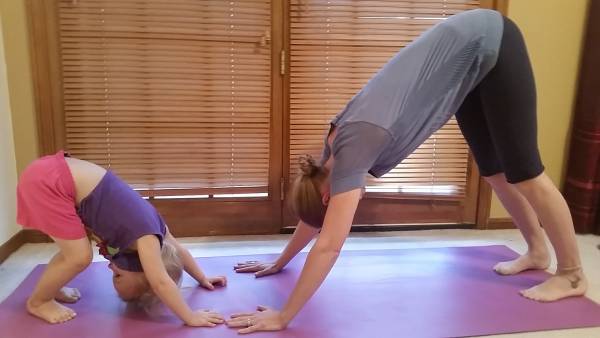
Downward Dog
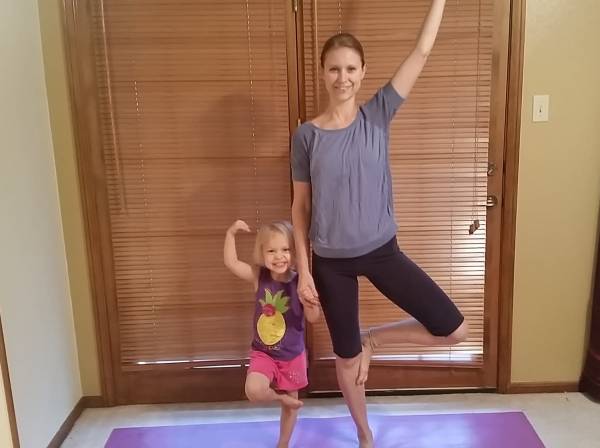
Tree
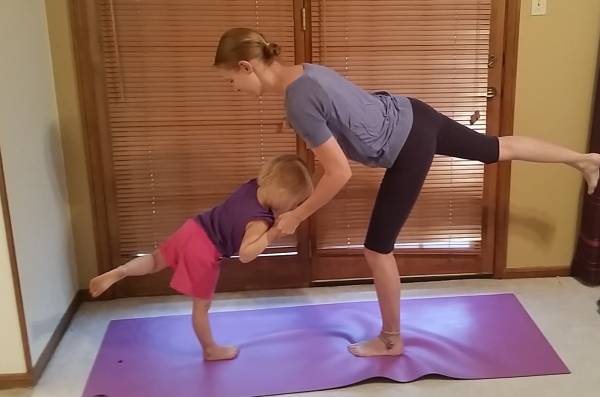
Partner Half Moon
The Vata Child: Bonding and Calming With Partner Yoga
Although my youngest is only seventeen months, he shows signs of being dominated by the vata dosha. Here’s a description of the vata child from Yoga Journal:
Touch is the magic word for the vata child: It soothes their restless, excitable vata nature. Regularity of routine is also very important for vatas, as irregular meals and changing bedtimes will tend to bring out the overexcitability, restlessness, and moodiness that can signal an imbalanced vata. A vata child should get plenty of rest and never be allowed to skip meals or grab a bite on the run.
Ever since he was born, my son has been easily soothed by being held and massaged. Now that he’s older and more mobile, he still loves physical connection. One way to use yoga with vata-dominant children is through partner yoga. Here are some poses to bond with your vata child:
- Flying
- Yogi Squat
- Fish Under Bridge
- Downdog with Gentle Backbend

Flying variations
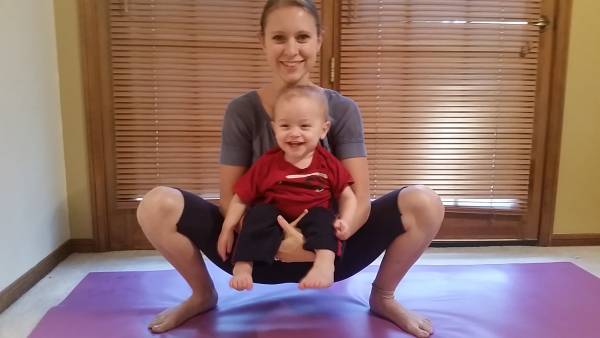
Squat
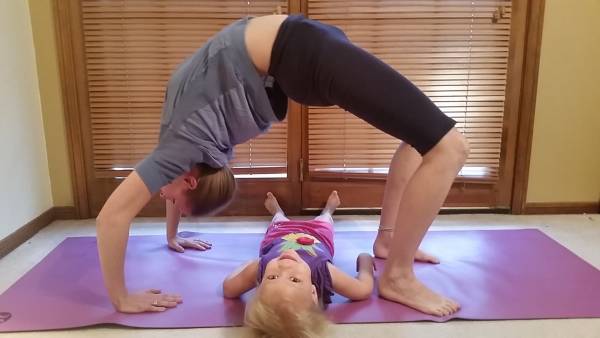
Fish Under the Bridge
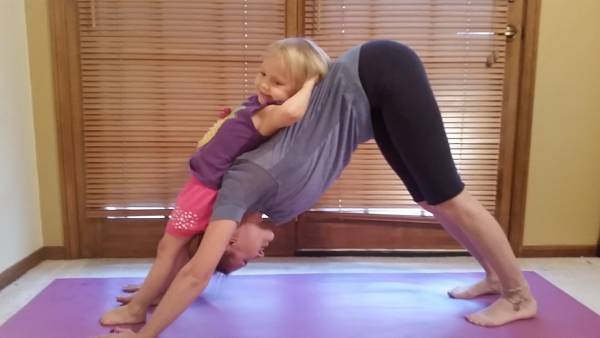
Downward Dog with Gentle Backbend
Yoga Can Help Your Child Grow
Remember the doshas are not cookie-cutter descriptions. To some extent, all of these principles are always at work. By tuning in to which are out of balance in our kids, we can use yoga not just as a means of physical exercise, but as a tool for personal development and growth.
Check out these other articles:
- Channel That Energy! 3 Benefits of Yoga for Toddlers
- Yoga Is the Answer to the Problems Kids Face Today
- Fit Kids Are Happier and Healthier
- What’s New on Breaking Muscle Today
Photo 1 courtesy of Shutterstock.






